Author: Dr. Monika Risse
Naturally occurring radioactivity is everywhere; however, artificial radiation sources are also widely used, for example in medicine. Radioactivity can be harmful to humans but we do not have a sensory organ to detect it. Humans are therefore reliant on measurement devices in situations involving nuclear or radioactive substances. The key tasks of such devices are monitoring, detecting and identifying radiation.
Measurement devices therefore need to meet different requirements depending on the application scenario, which is why a multitude of different devices exist. There are different device classes for different applications, for example personal radiation dosimeters (PRDs) and hand-held radionuclide identification devices (RIIDs). Spectroscopic personal radiation detectors (SPRD) represent a class in between. If you consider, for example, a scenario in which a radiation source of unknown origin is detected, a collective requirement for all measurement systems is the ability to deliver reliable results within a short time-frame. When evaluating the measurement results, it is important to be able to assess how reliable the device results are. Qualification measurements in accordance with existing, defined test procedures can provide valuable information on the quality of results. The results of such tests inform users and manufacturers how reliably a measurement device can detect, locate or identify radiation sources. It is also critical to become familiar with all aspects of a device prior to its use and to practice with radiation sources.
A measurement device that is available on the market for these tasks is the D3S by Kromek. This article presents the test results which were obtained using the QuTeSt (Qualification Test System for Radiation Detection Devices) developed by the Nuclear Security Policy and Detection Techniques (NSD) business unit and which was then used to assess the device’s performance. The D3S can be used both as a PRD and an RIID. There are different measurement standards for these device classes, which form the basis for testing the devices. Many years of experience in device testing has resulted further, additional tests that provide an even more detailed picture of the reliability of a device.
Qualifications tests are performed with regard to different functional areas, for example in relation to false alarms and false identifications, the general triggering of an alarm, the accuracy of the photon measurement results, the duration until the alarm is triggered, the measurement device’s response to radiation outside the measurement range specified by the manufacturer or even in terms of a neutron detector’s response behavior to gamma radiation. For example, the neutron component of the D3S proved to be insensitive to the influence of a very strong gamma source and no neutron alarm was triggered. The most important measurement standards for these qualification tests are those of the American National Standards Institute (ANSI) and the International Electrotechnical Commission (IEC) as well as the procedures developed as part of the EU research project »ITRAP+10« (Illicit Trafficking Radiation Detection Assessment Program + 10).
The D3S comprises two components: the detector part (see the measurement setup image), which includes a cesium iodide gamma detector and a lithium-based neutron component, and a smartphone linked to the detector via Bluetooth that acts as a data processing and display unit. The detector part is shaped like a smartphone and allows first-line responders to carry it on their body.The measurement results are issued audibly, visually and via a vibration alarm on the smartphone. Tests were performed on two different generations of D3S: one D3S from 2016 (old D3S), which already underwent very extensive testing, and one D3S from 2019 (new D3S). The old D3S originally used firmware version 3.31, but the firmware has been updated so both devices now have firmware 3.77. Both, a comparison between two different hardware versions (2016 and 2019) and between two different firmware versions was thus possible. The latest firmware version is notably characterized by several changes regarding how the dose rate is determined. Considering the influence of the firmware on the measurement results is of particular interest because measurement systems must always be considered as a whole. A good detector material alone is no guarantee of a reliable and accurate measurement, and a very good analysis routine can provide quite a good result even using the spectrum of a detector material that has a lower resolution or is less efficient. Device characteristics also cannot be considered individually and independently from each other. For example, inaccuracies in the photon measurement results have an effect on identification results as well as on the behavior of the measurement device outside the measurement range specified by the manufacturer. It is also important to perform tests over the entire gamma energy range and for different dose rates.
In terms of the accuracy of dose rate measurements, it is necessary to note that this device class does not involve calibrated radiation measurement devices; these are not used in radiation protection and therefore, measurement standards generally allow for greater tolerance in terms of accuracy. The table provides an overview of the requirements for RIIDs specified by different measurement standards. While the ANSI standard specifies a test using only one isotope, the IEC and ITRAP+10 standards both cover a significantly larger energy range using two additional isotopes. The accuracy of the dose rate measurement results should be tested up to the maximum specified by the manufacturer. According to the product information, the maximum for the D3S is 15 μSv/h for the 2016 device and 20 μSv/h for the 2019 one.
During the tests, the true dose rates were calculated using a calibrated reference instrument and the measurements were then compared. The measurement results for 137Cs are presented in the graph; the displayed measurements are the averages of 30 individual and independent measurements. The results of the old and new D3S using the same, new firmware correlate very closely to the reference values. However, the results using the old firmware deviate significantly. For 5 μSv/h, the deviation is greater than 100% and, with the exception of the measurement for 100 μSv/h, all measurements recorded lie outside of the permitted tolerance range. It is striking that conformity of the new firmware in the range below 20 μSv/h is very good and lies within ± 10% stipulated by ANSI. The device would therefore pass the test according to the ANSI standard for RIIDs. However, the deviation at 100 μSv/h was over 50%. The measurement recorded was far too low, which could lead to a seriously inaccurate risk assessment of the actual situation. With regard to the IEC and ITRAP+10 standards, the device does not pass the tests in any configuration.
Before using a radiation measurement device, it is therefore necessary to know its performance capacity, not least to protect first-line responders. The results of independent laboratories, which perform tests according to international standards and evaluate the results, are used for this purpose. Using the QuTeSt, Fraunhofer INT is in the position to perform such tests.
 Fraunhofer Institute for Technological Trend Analysis INT
Fraunhofer Institute for Technological Trend Analysis INT
